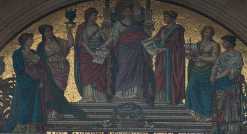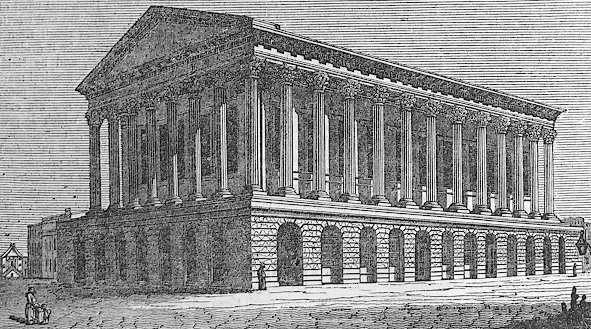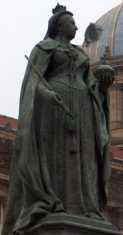 Mosaic on the Council House.
Mosaic on the Council House.
The Council House, Museum and Art Gallery was conceived as a whole by the architect Yeoville Thomason: first the Council House in 1874-79, then the Museum and Art Gallery in 1881-85. It is classical in the Renaissance style, with a big clock tower on the left hand corner as you look at the building (‘Big Brum’ as opposed to London’s Big Ben), and a tower with dome set back from the massive many-pillared portico, which stretches up past the three-storey main building in a Baldacchino type structure. There are many pillars, on two levels (the higher ones are double-storey), a pediment, and a huge lunette of Salviati mosaic, depicting Britannia rewarding the Birmingham Manufactures. There are seven allegorical females, obligingly labelled, with the central figure of the Municipality of Birmingham handing out scrolls of Stability and Power. The composition is simple, necessary given the great height above the ground. Note the very fine drapery. One oddity is the fire on the contraption to the right of the design, which throws no light on the shoulder, arm and side of the rightmost figure of Industry.
The sculpture in the pediment (above) likewise contains 7 figures, in a more triangular composition. Here the central figure, again a Britannia, is on a larger scale than the subordinate figures, who are all male. Britannia holds out her arms, each holding a wreath above the heads of the two best-dressed men – the one on the left is probably a trader rather than a maker, as he holds his hand as if with money (the other carries a pot), and has little scales for gold or jewels next to him. To his left, a press operator and a reclining man with some heavy machinery – pots, a toothed wheel and some other bits and bobs fill the left hand corner of the pediment. To the right, a pair of figures in tunics with pots, and a machine operator with perhaps a lathe, and a small mallet in hand. A rather spare treatment throughout, bar the drapes on the arms of the central figure. The sculptor was F. J. Williamson.
Various more minor decoration, and on the first floor balcony, half a dozen upright-seated stone lions.
Round the corner of the building, are three flat semicircular and one triangular pediment, all rather smaller than the one to the front. The triangular pediment, directly above the entrance to the Museum and Art Gallery, again has seven figures – four of these are putti to allow for the smaller size of the space, and only the other three are shown in the picture above. This time, the central female figure is gracefully disposed on a throne, and wears a heavy cloak. To the left is seated the Painterly arts, as a more lightly draped seated girl, with pencil and small easel – the two corner putti have a palette and brush and a scroll. On the right, the Plastic arts, with a crouching man holding a statue: the first putti on this side appears to be using his sculptor’s hammer to model another statue, while the other has two pieces of the potter’s art. A better group than that on the front.
Now to the semicircular pediment sculpture. Our first picture, above, is of a nice symmetrical though slightly informal arrangement of eight classical girls, and the shape of the space means that six of these (above) can be more or less in line, though the pair of central figures are seated and the others standing. The two flanking figures are again seated, but lower to fill in the descending ends of the arched top. Very Greek, these girls, in drapery and pose, with conscious references to classical works. Of the two central figures, seated on a raised plinth, the one on our right is slightly more prominent, and holds the regulator from a steam engine, in bronze. Together with her companion she holds a palm frond between them, and this other also holds a bust of probably Athena. That bust though belongs to the next, standing figure on the left, Sculpture, with her mallet, who has a companionable arm around the shoulders of Painting next to her. The capital of a pillar does duty for Architecture, and Music is the outermost figure, completing the Arts. To the right, the Sciences, with the first standing figure holding an hourglass, though her next companion has lost whatever she was holding. Finally, the girl seated to the right has a sectioned globe, some geometrical diagram, and a heap of books. An excellent and most admirable group.
The next semicircular pediment (above), again worth study, is back to the group of seven figures, all to do with Manufactures. The centremost figure, who would dwarf the others were she to stand, is seated, and leans on a mallet. To the left, a standing figure of Gun Manufacture, behind her perhaps Silverware, while the kneeling man at the left hand edge of the group has a variety of pots and tools. On the right, a girl with a spinning wheel, a second with completed cloths, and a man beating something on an anvil. The figures on the left are in profile, those to the right three-quarters face, and the central figure looks towards them, perhaps indicating that these are the more recent and expanding areas of Birmingham manufacture.
The final semicircular pediment, shown here, manages no less than nine figures, by dint of tucking two reclining next to and beneath the central one. The central figure is an angel, male but with an androgynously female face, enfolding wings and a sunburst sketched in behind. All the other figures are female, and rather smaller. They hold a variety of smaller items, including books, pots, and a board with 14 shallow-cut depressions, perhaps indicative of toymaking, an important Birmingham speciality in earlier times. The symmetrical composition is given pleasing variety by the range of poses and directions of gaze of the figures.
Finally, much of the rest of the building is encrusted with bands of ornament, based on the floral, but with a variety of little faces, birds, beasts and emblems among the foliage and flowers.
Across the square stands the old Town Hall, a superior Roman-style temple, of the Corinthian order, put up in the 1830s by the architectural partnership of J. A. Hansom and Edward Welch, who went bankrupt over this building.
 The old Town Hall, by J. A. Hansom and Welch.
The old Town Hall, by J. A. Hansom and Welch.
We can take Chamberlain Square and the adjacent Victoria Square as a piece. The principal
monument is the Gothic shrine to Joseph Chamberlain, erected in his own lifetime in 1880, by J. H.
Chamberlain. Portland stone, with minor leafy ornament, and mosaic leaves on a gold background, and a medallion portrait
in profile of Chamberlain by Thomas Woolner.
We note three Victorian statues. The bronze statue of Queen Victoria is by Thomas Brock,
and apparently is a cast of 1951 from an original stone version on the same site dating from 1901,
though she looks younger than that. She is shown standing in fairly conventional pose, but with much
made of the drape of the cloak over her left arm.
The statue of James Watt is by Alexander Munro, and the
dandyish one of Priestley dating from 1874 by F. J. Williamson,
who did the art gallery pediment referred to above.
The modern sculpture in the Square is described on this page.
Birmingham pages // Sculpture in England // Sculptors // Pediment sculpture.
Visits to this page from 23 Nov 2011: 2,002 since 6 October 2024
 Queen Victoria, by Thomas Brock.
Queen Victoria, by Thomas Brock.